| Revision as of 03:12, 11 November 2013 editJprg1966 (talk | contribs)Extended confirmed users, Pending changes reviewers, Rollbackers95,524 editsm Cleaned up using AutoEd← Previous edit | Revision as of 15:19, 9 December 2013 edit undoColdcreation (talk | contribs)Extended confirmed users, Rollbackers24,701 edits Selections from the permanent collection of paintingsNext edit → | ||
| Line 242: | Line 242: | ||
| |} | |} | ||
| * At the exit of Southwark tube station, orange lamposts direct visitors to Tate Modern. | * At the exit of Southwark tube station, orange lamposts direct visitors to Tate Modern. | ||
| == Selections from the permanent collection of paintings== | |||
| <gallery widths="180px" heights="180px" perrow="4"> | |||
| Image:Albert Gleizes, 1911, Portrait de Jacques Nayral, oil on canvas, 161.9 x 114 cm, Tate Modern, London.jpg|], 1911, '']'', oil on canvas, 161.9 x 114 cm. This painting was reproduced in ''Fantasio'': published 15 October 1911, for the occasion of the [[Salon d'Automne'' where it was exhibited the same year. | |||
| File:Georges Braque, 1909-10, La guitare (Mandora, La Mandore), oil on canvas, 71.1 x 55.9 cm, Tate Modern, London.jpg|], 1909-10, ''La guitare (Mandora, La Mandore)'', oil on canvas, 71.1 x 55.9 cm | |||
| File:Pablo Picasso, 1909-10, Figure dans un Fauteuil (Seated Nude, Femme nue assise), oil on canvas, 92.1 x 73 cm, Tate Modern, London.jpg|], 1909-10, ''Figure dans un Fauteuil (Seated Nude, Femme nue assise)'', oil on canvas, 92.1 x 73 cm. This painting from the collection of ] was confiscated by the French state and sold at the ] in 1921 | |||
| File:Juan Gris 001.jpg|], 1914, ''The Sunblind'', collage and oil on canvas, 92 × 72.5 cm | |||
| File:Londres tate modern kirchner baigneurs.jpg|], 1909/1926, ''Baigneurs à Moritzburg'' | |||
| File:A Young Lady's Adventure.JPG|], 1921, ''A Young Lady's Adventure'', watercolor on paper, 43.8 × 30.8 cm | |||
| File:Londres tate modern klee nuit walpurgis.jpg|], 1935, ''La nuit de Walpurgis '' | |||
| File:'Endless Rhythm' by Robert Delaunay, Tate Modern.JPG|], 1934, ''Endless Rhythm'' | |||
| </gallery> | |||
| ==See also== | ==See also== | ||
Revision as of 15:19, 9 December 2013
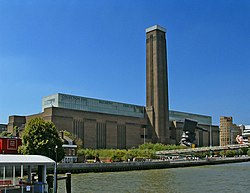 | |
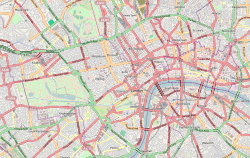 | |
| Established | 2000 |
|---|---|
| Location | Bankside, London SE1, England, United Kingdom |
| Visitors | 5,318,688 (2012) |
| Director | Chris Dercon |
| Public transit access | Blackfriars, Southwark |
| Website | www.tate.org.uk/modern |
| Tate | |

Tate Modern is a modern art gallery located in London. It is Britain's national gallery of international modern art and forms part of the Tate group (together with Tate Britain, Tate Liverpool, Tate St Ives and Tate Online). It is the most-visited modern art gallery in the world, with around 4.7 million visitors per year. It is based in the former Bankside Power Station, in the Bankside area of the London Borough of Southwark. Tate holds the national collection of British art from 1500 to the present day and international modern and contemporary art.
History
- Main article Bankside Power Station
The galleries are housed in the former Bankside Power Station, which was originally designed by Sir Giles Gilbert Scott, the architect of Battersea Power Station, and built in two stages between 1947 and 1963. The power station closed in 1981. In 1992 The Tate Gallery at the British National Art Museum proposed a competition to build a new building for modern art. The purpose for the new building would help with the ever-expanding collection on modern and contemporary art. In 1995 itwas announced that Herzog & de Meuron had won the competition with their simple design. The architects decided to reinvent the current building instead of demolishing it. The Tate modern is an example of adaptive reuse, the process of finding new life in old buildings. The building itself still resembles the 20th century factory in style from the outside and that is reflected on the inside by the taupe walls, steel girders and concrete floors. The façade of the building is made out of 4.2 million bricks that are separated by groups of thin vertical windows that help create a dramatic light inside. The history of the site as well as information about the conversion was the basis for a 2008 documentary Architects Herzog and de Meuron: Alchemy of Building & Tate Modern. This challenging conversion work was carried by Carillion. The southern third of the building was retained by the French power company EDF Energy as an electrical substation (in 2006, the company released half of this holding).
The galleries

The collections in Tate Modern consist of works of international modern and contemporary art dating from 1900 until today.
Tate Modern currently has seven floors, originally numbered 1 to 7, they were renumbered 0 to 6 in 2012. Levels 0 to 4 contain gallery space.
Collection exhibitions
The main collection displays consist of 4 wings each taking up approximately half a complete floor of the main building. Each wing has a named theme or subject. Within each wing there are some rooms that change periodically showing different works in keeping with the overall theme or subject of the wing.
Previous collection exhibitions

When the gallery opened in 2000, the collections were not displayed in chronological order but were rather arranged thematically into four broad groups each allocated a wing on levels 3 and 5 (now levels 2 and 4):
- 'History/Memory/Society'
- 'Nude/Action/Body'
- 'Landscape/Matter/Environment'
- 'Still Life/Object/Real Life'
This was ostensibly because a chronological survey of the story of modern art along the lines of the Museum of Modern Art in New York would expose the large gaps in the collections, the result of the Tate's conservative acquisitions policy for the first half of the 20th century.
The first rehang at Tate Modern opened in May 2006. It eschewed the thematic groupings in favour of focusing on pivotal moments of twentieth-century art. It also introduced spaces for shorter exhibitions in between the wings. The layout was:
- Material Gestures (now closed)
This focuses on abstraction, expressionism and abstract expressionism, featuring work by Claude Monet, Anish Kapoor, Barnett Newman, Mark Rothko, Henri Matisse and Tacita Dean.
- Poetry and Dream
This features a large central room dedicated to Surrealism while the surrounding rooms feature works by artists influenced by Surrealism and its methods.
- Energy and Process
This focuses on Arte Povera, with work by artists such as Alighiero Boetti, Jannis Kounellis, Kasimir Malevich, Ana Mendieta, Mario Merz and Jenny Holzer.
- States of Flux (now closed)
This focuses on Cubism, Futurism, Vorticism and Pop Art, containing work by artists such as Pablo Picasso, Roy Lichtenstein, Andy Warhol and the photographer Eugène Atget,
Current collection exhibitions
As of mid-2012, a third rehang is in progress. The current arrangement is:
- Poetry and Dream
As above.
- Structure and Clarity
Focussing on abstract art, replacing States of Flux.
- Transformed Visions
Focusing on Abstract Impressionism and related fields after the Second World War, replacing Material Gestures.
- Energy and Process
As above.
- Setting the Scene
A smaller section, located between wings, covering installations with theatrical or fictional themes.
It has not been announced whether the current rehang will eventually replace all four of the sections introduced in the first rehang.
Temporary exhibitions
The Turbine Hall
The Turbine Hall, which once housed the electricity generators of the old power station, is five storeys tall with 3,400 square metres of floorspace. It is used to display large specially-commissioned works by contemporary artists, between October and March each year. This series was planned to last the gallery's first five years, but the popularity of the series has led to its extension until at least 2012.
The artists who have exhibited commissioned work in the turbine hall as part of the Unilever series are:
| Date | Artist | Work(s) | Details |
|---|---|---|---|
| May 2000 – November 2000 | Louise Bourgeois | I Do, I Undo, I Redo | About |
| June 2001 – March 2002 | Juan Muñoz | Double Bind | About |
| October 2002 – April 2003 | Anish Kapoor | Marsyas | About |
| October 2003 – March 2004 | Olafur Eliasson | The Weather Project | About |
| October 2004 – May 2005 | Bruce Nauman | Raw Materials | About |
| October 2005 – May 2006 | Rachel Whiteread | EMBANKMENT | About |
| October 2006 – April 2007 | Carsten Höller | Test Site | About |
| October 2007 – April 2008 | Doris Salcedo | Shibboleth | About |
| October 2008 – April 2009 | Dominique Gonzalez-Foerster | TH.2058 | About |
| October 2009 – April 2010 | Miroslaw Balka | How It Is | About |
| October 2010 – April 2011 | Ai Weiwei | Sunflower Seeds | About |
| October 2011 – March 2012 | Tacita Dean | Film | About |
| July 2012 – October 2012 | Tino Sehgal | These Associations | About |
Until 2012, the series was named after its corporate sponsor, Unilever. Between 2000 and 2012, Unilever had provided £4.4m sponsorship in total including a renewal deal of £2.2m for a period of five years agreed in 2008. When the series is not running, the Turbine Hall is used for occasional events and exhibitions. Most recently it has been used to display Damien Hirst's For The Love Of God and a sell out show by Kraftwerk in February 2013 which famously crashed the ticket hotline and website causing a backlash from the band's fans.
Major temporary exhibitions
Two wings of the main building are used to stage the major temporary exhibitions for which an entry fee is charged. These exhibitions normally run for three or four months. When they were located on a single floor, the two exhibition areas could be combined to host a single exhibition. This was done for the Gilbert and George retrospective due to the size and number of the works. Currently the two wings used are on levels 2 and 3. It is not known if this arrangement is permanent. Each major exhibition has a dedicated mini-shop selling books and merchandise relevant to the exhibition.
The Tanks
The Tanks, located on level 0, are three large underground oil tanks, connecting spaces and side rooms originally used by the power station and refurbished for use by the gallery. One tank is used to display installation and video art specially commissioned for the space while smaller areas are used to show installation and video art from the collection.
Project Space
The Project Space (formerly known as the Level 2 Gallery) is a smaller gallery located on the north side of the building on level 1 which houses exhibitions of contemporary art in collaboration with other international art organisations. Its exhibitions typically run for 2–3 months and then travel to the collaborating institution for display there.
Other areas
Small exhibition spaces can be created between the wings on levels 2 to 4. These have been used used to display recent acquisitions and other temporary displays from the collection. Works are also sometimes shown in the restaurants and members' room. Other locations that have been used in the past include the mezzanine on Level 1 and the north facing exterior of the building.
Other facilities
In addition to exhibition space there are a number of other facilities:
- A large performance space in one of the tanks on level 0 used to show a changing programme of performance works for which there is sometimes an entrance charge.
- The Starr Auditorium and a seminar room on level 1 which are used to show films and host events for which there is usually an entrance charge.
- The Clore Education Centre, Clore Information Room and McAulay Studios on level 0 which are facilities for use by visiting educational institutions.
- One large and several small shops selling books, prints and merchandise.
- A cafe, an espresso bar, a restaurant and bar and a members' room.
Extension project
Tate Modern has attracted more visitors than originally expected and plans to expand it have been in preparation since 2004. These plans are focused on the south west of the building and will provide 5,000m of new display space, almost doubling the amount of display space.
This project was initially costed at £215 million Of the money raised, 50 million pounds is coming from the U.K. government; 7 million pounds from the London Development Agency; 5 million pounds from philanthropist John Studzinski; and donations from, among others, the Sultanate of Oman and Elisabeth Murdoch.
As of 2 June 2013, international shipping and property magnate Eyal Ofer pledged £10m to the extension project, making it to 85% of the required funds. Eyal Ofer, chairman of London-based Zodiac Maritime Agencies, said the donation made through his family foundation would enable "an iconic institution to enhance the experience and accessibility of contemporary art". The Tate director, Nicholas Serota, praised the donation saying it would help to make Tate Modern a "truly twenty-first-century museum".
The Tanks
The first phase of the expansion involved the conversion of three large, circular, underground oil tanks originally used by the power station into accessible display spaces and facilities areas. These opened on 18 July 2012 and are used to show live performance art and installations. Tate describes them as "the world's first museum galleries permanently dedicated to live art".
The western block
The new western block will occupy the space no longer required by EDF Energy for their electrical substation. The original block has been demolished and a new building will be built with large gallery spaces and access routes between the main building and the new tower on level 1 (ground level) and level 4. The new galleries on level 4 will have natural top lighting. A bridge will be built across the turbine hall on level 4 to complete the upper access route.
The tower
A ten storey tower is being built above the oil tanks. It is scheduled to open in 2016.
The design, also designed by Herzog & de Meuron, has been controversial. It was originally designed as a glass stepped pyramid, or zigurat, but this was amended to incorporate a sloping façade in brick latticework (to match the original power-station building) after the feedback on the original design was unfavourable.
The tower will include galleries dedicated to photography, video, exhibitions and the community. There will be a viewing terrace at the top.
The Chimney
The chimney is one of the most recognizable monuments on The South bank. It is directly across the river from Saint Paul’s Cathedral. The chimney stands at 325 ft, made completely out of brick except for The Swiss Light added on top by the architects Herzog and De Meuron.
Access and environs

The closest station is Blackfriars via its new south entrance. Other nearby stations include Southwark, as well as St Paul's and Mansion House north of the river which can be reached via the Millennium Bridge. The lampposts between Southwark tube station and Tate Modern are painted orange to show pedestrian visitors the route.
There is also a riverboat pier just outside the gallery called Bankside Pier, with connections to the Docklands and Greenwich via regular passenger boat services (commuter service) and the Tate to Tate service, which connects Tate Modern with Tate Britain.
To the west of Tate Modern lie the sleek stone and glass Ludgate House, the former headquarters of Express Newspapers and Sampson House, a massive late Brutalist office building.
Transport connections
| Service | Station/Stop | Lines/Routes served | Distance from Tate Modern |
|---|---|---|---|
| London Buses |
Southwark Street / Blackfriars Road |
RV1 | 0.2 mile walk |
| Blackfriars Bridge |
381, N343, N381 | 0.2 mile walk | |
| Blackfriars Bridge / South Side |
45, 63, 100, N63, N89 | 0.2 mile walk | |
| Southwark Bridge / Bankside Pier |
344 | 0.4 mile walk | |
| London Underground |
Southwark |
0.4 mile walk | |
| National Rail |
Blackfriars |
First Capital Connect, Southeastern | 0.5 mile walk |
| London Bridge |
First Capital Connect, Southern, Southeastern | 0.7 mile walk | |
| London River Services |
Bankside Pier |
Commuter Service Tate to Tate Westminster to St Katharine's Circular |
- At the exit of Southwark tube station, orange lamposts direct visitors to Tate Modern.
Selections from the permanent collection of paintings
-
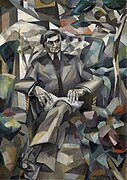 Albert Gleizes, 1911, Portrait de Jacques Nayral, oil on canvas, 161.9 x 114 cm. This painting was reproduced in Fantasio: published 15 October 1911, for the occasion of the [[Salon d'Automne where it was exhibited the same year.
Albert Gleizes, 1911, Portrait de Jacques Nayral, oil on canvas, 161.9 x 114 cm. This painting was reproduced in Fantasio: published 15 October 1911, for the occasion of the [[Salon d'Automne where it was exhibited the same year.
-
 Georges Braque, 1909-10, La guitare (Mandora, La Mandore), oil on canvas, 71.1 x 55.9 cm
Georges Braque, 1909-10, La guitare (Mandora, La Mandore), oil on canvas, 71.1 x 55.9 cm
-
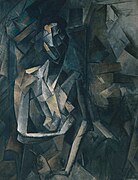 Pablo Picasso, 1909-10, Figure dans un Fauteuil (Seated Nude, Femme nue assise), oil on canvas, 92.1 x 73 cm. This painting from the collection of Wilhelm Uhde was confiscated by the French state and sold at the Hôtel Drouot in 1921
Pablo Picasso, 1909-10, Figure dans un Fauteuil (Seated Nude, Femme nue assise), oil on canvas, 92.1 x 73 cm. This painting from the collection of Wilhelm Uhde was confiscated by the French state and sold at the Hôtel Drouot in 1921
-
 Juan Gris, 1914, The Sunblind, collage and oil on canvas, 92 × 72.5 cm
Juan Gris, 1914, The Sunblind, collage and oil on canvas, 92 × 72.5 cm
-
 Ernst Ludwig Kirchner, 1909/1926, Baigneurs à Moritzburg
Ernst Ludwig Kirchner, 1909/1926, Baigneurs à Moritzburg
-
Paul Klee, 1921, A Young Lady's Adventure, watercolor on paper, 43.8 × 30.8 cm
-
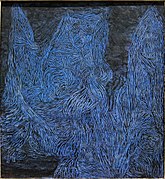 Paul Klee, 1935, La nuit de Walpurgis
Paul Klee, 1935, La nuit de Walpurgis
-
Robert Delaunay, 1934, Endless Rhythm
See also
References
- "Visits made in 2012 to visitor attractions in membership with ALVA". Association of Leading Visitor Attractions. Retrieved 16 June 2013.
- "History and development Tate On-line". Tate.org.uk. Retrieved 8 January 2013.
- "The startling success of Tate Modern". The Times. 24 April 2010. Retrieved 19 October 2010.
- "About". Tate. Retrieved 8 January 2013.
- "Tate Modern builders Carillion win £400m Battersea Power Station contract". Your local Guardian. 23rd May 2013. Retrieved 27 September 2013.
{{cite web}}: Check date values in:|date=(help) - Riding, Alan (26 July 2006). "Tate Modern Announces Plans for an Annex". The New York Times. Retrieved 26 July 2006.
- Tate Modern: About
- Tate Modern | Collection Displays | Level 3: Material es, Tate Online, 2006. URL accessed on 9 February 2007.
- "Collection Displays. Level 3: Poetry and Dream". Tate. Retrieved 8 January 2013.
- Tate Modern | Collection Displays | Level 5: Idea and Object, Tate Online, 2006. URL accessed on 9 February 2007.
- Tate Modern | Collection Displays | Level 5: Idea and Object | Image/Text (Room 11), Tate Online, 2006. URL accessed on 9 February 2007.
- Tate Modern | Collection Displays | Level 5: States of FluxTate Online, 2006. URL accessed on 9 February 2007.
- Tate Modern | Collection Displays | Level 5: States of Flux | Cubism, Futurism, Vorticism (Room 2), Tate Online, 2006. URL accessed on 9 February 2007.
- Tate Modern | Collection Displays | Level 5: States of Flux | Pop (Room 7)Tate Online, 2006. URL accessed on 9 February 2007.
- Tate Modern | Collection Displays | Level 5: States of Flux | Machine Eye (Room 4)Tate Online, 2007. URL accessed on 9 February 2007.
- "Collection Displays". Tate. 10 April 2012. Retrieved 8 January 2013.
- "Structure and Clarity". Tate. Retrieved 8 January 2013.
- "Transformed Visions". Tate. 23 July 2012. Retrieved 15 August 2012.
- "Setting the Scene". Tate. Retrieved 8 January 2013.
- Brooks, Xan (7 October 2005). "Profile: Rachel Whiteread". The Guardian. London. Retrieved 20 April 2006.
- "Dominique Gonzalez-Foerster Chosen for Tate Modern's Turbine Hall". Retrieved 16 September 2008.
- "The Unilever Series". Tate. Retrieved 8 January 2013.
- Gareth Harris (August 14, 2012), Tate seeks new sponsor for Turbine Hall commissions The Art Newspaper.
- "Damien Hirst's iconic For the Love of God to be shown in Tate Modern's Turbine Hall". Tate. 21 November 2011. Retrieved 15 August 2012.
- Tate Modern: Gilbert & George Exhibition
- Tate Modern: Street Art
- ^ Tate Guide, August–September 2012
- "Vision". Tate. Retrieved 15 August 2012.
- Tate Modern's chaotic pyramid, The Times, 26 July 2006. URL accessed on 26 July 2006.
- Farah Nayeri (April 20, 2012), Murdoch’s Daughter Elisabeth Gives Tate at Least $1.6 MlnBloomberg.
- http://www.ft.com/cms/s/2/73bfec0c-e32f-11e2-bd87-00144feabdc0.html#axzz2XtlPAgSa
- http://www.guardian.co.uk/artanddesign/2013/jul/02/tate-modern-gift-eyal-ofer
- "The Tanks: Art in Action". Tate. Retrieved 8 January 2013.
- "Tate Modern extension redesigned". Worldarchitecturenews.com. 18 July 2008. Retrieved 8 January 2013.
- Tate modern | Transforming Tate Modern, Tate Online, 2006. URL accessed on 30 March 2007.
- "Walking directions to Tate Modern from Southwark Street / Blackfriars Road bus stop" (Map). Google Maps. Retrieved 28 February 2012.
- "Walking directions to Tate Modern from Blackfriars Bridge bus stop" (Map). Google Maps. Retrieved 28 February 2012.
- "Walking directions to Tate Modern from Blackfriars Bridge / South Side bus stop" (Map). Google Maps. Retrieved 28 February 2012.
- "Walking directions to Tate Modern from Southwark Bridge / Bankside Pier bus stop" (Map). Google Maps. Retrieved 28 February 2012.
- "Walking directions to Tate Modern from Southwark tube station" (Map). Google Maps. Retrieved 28 February 2012.
- "Walking directions to Tate Modern from Blackfriars station" (Map). Google Maps. Retrieved 28 February 2012.
- "Walking directions to Tate Modern from London Bridge station" (Map). Google Maps. Retrieved 28 February 2012.
External links
- Tate Online - Official Tate website
- 'Tate Modern: a Year of Sweet Success' by Esther Leslie, in Radical Philosophy
- The buildings of Bankside Power Station(Tate Modern) and Battersea Power Station compared
- Inside Bankside Power Station with Antony Gormley 1991 (http://www.youtube.com/watch?v=lCxl2tKuo3Y)
| Tate | |
|---|---|
| Galleries | |
| Directors |
|
| Benefactors | |
| Exhibitions | |
| Other | |
| London Borough of Southwark | ||
|---|---|---|
| Districts |   | |
| Attractions |
| |
| Markets and shopping | ||
| Bridges and tunnels | ||
| Parks and open spaces |
| |
| Constituencies | ||
| Tube and rail stations | ||
| Other topics | ||
| London landmarks | |||||||||||||||||||||||||||||||||||||||||
|---|---|---|---|---|---|---|---|---|---|---|---|---|---|---|---|---|---|---|---|---|---|---|---|---|---|---|---|---|---|---|---|---|---|---|---|---|---|---|---|---|---|
| Buildings and structures |
| ||||||||||||||||||||||||||||||||||||||||
| Parks |
| ||||||||||||||||||||||||||||||||||||||||
| Squares and public spaces | |||||||||||||||||||||||||||||||||||||||||
| Streets |
| ||||||||||||||||||||||||||||||||||||||||
Categories:
- Use dmy dates from August 2010
- Tate structures
- Energy infrastructure completed in 1947
- Energy infrastructure completed in 1963
- Art museums established in 2000
- 2000 establishments in England
- Art museums and galleries in London
- British art
- Modern art museums
- Contemporary art galleries in the United Kingdom
- Museums sponsored by the Department for Culture, Media and Sport
- Redevelopment projects in London
- Buildings and structures in London
- Museums in Southwark
- Museums on the River Thames
- Herzog & de Meuron buildings
- 2000 in London